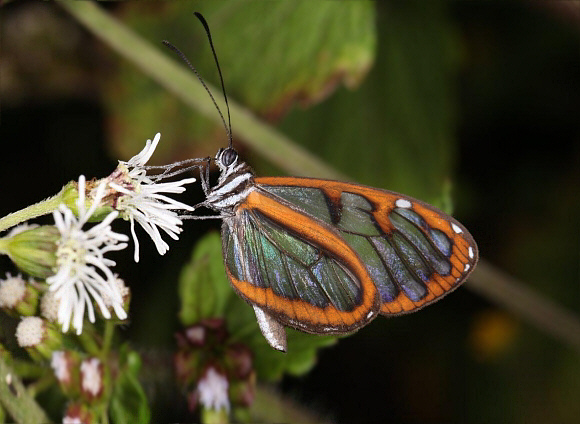
Introduction
The Ithomiini comprises of 376 known species, although it is likely that at least another 30 will be discovered in the near future. All are confined to the neotropical region. Ithomiines are unpalatable to birds, and are consequently mimicked in appearance by many other species. These include other unpalatable species ( Müllerian mimics ), not only from the Ithomiinae but also from several other butterfly families. There are also a large number of edible species ( Batesian mimics ) which have evolved similar patterns. Birds have the ability to memorise butterfly patterns and so learn to avoid eating noxious species, but are also fooled into ignoring similarly marked edible species.
Ithomiines are characterised by having small eyes, slender abdomens and long drooping antennae that lack distinct clubs. Males have a plume of long androconial scales or “hair pencils” on the costa of their hindwings. These are hidden from view when the butterflies are at rest, but are displayed when the wings are held open during courtship. Other Ithomiine characteristics include a very slow and deep wing beat, and a preference for inhabiting the darkest recesses of the forest understorey.
The genus Oleria comprises of about 50 known species, recognisable from the distinctive venation of the hindwings.
Oleria tremona is found from Colombia to Bolivia.
Habitats
This species inhabits wet tropical rainforest habitats at altitudes between about 200-1200m.
Lifecycle
To be completed.
Adult behaviour
The adults are normally found in small “leks” of up to a dozen butterflies. The males fly very slowly and almost incessantly around the lek area, only pausing to settle for a moment here and there, at which time they slowly fan their wings, probably to aid dissemination of pheromones from the androconial “hairs” on their wings.
Males of most Oleria species visit Eupatorium, from which they acquire pyrrolizidine alkaloids which they pass to the females during copulation, and which is believed to be essential for the production of viable eggs.
Females visit various flowers for nectar and pollen – the latter may be essential in the production of eggs and the maintenance of ovaries, as has been demonstrated to be the case with Heliconiines. Females also receive proteins during sperm transfer.
Gravid females fly very slowly, periodically dipping down to investigate Solanum plants. Having found the foodplant they then spend 2 or 3 minutes testing it, using olfactory sensors on their legs, antennae and abdomens, to determine whether it is Solanum mite or another related species.
In common with most other Ithomiines, lateral and altitudinal migrations of Oleria species are triggered by seasonal changes in humidity.
